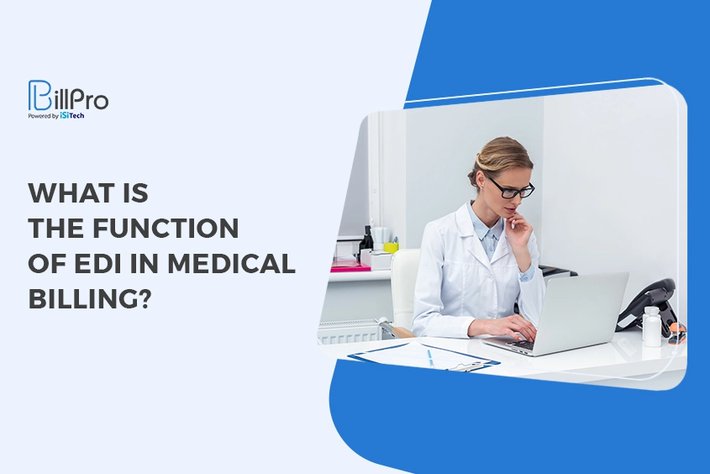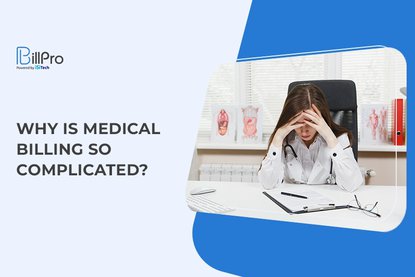Electronic Data Interchange (EDI) is the direct computer-to-computer exchange of documents in a standard electronic format. EDI enables companies to conduct business electronically with their partners, eliminating the need for paper documents and boosting overall efficiency.
EDI in medical billing has been used for many years and is the standard for exchanging patient information and claims between payers and providers.
EDI-compliant medical billing software can significantly reduce the time and effort required to process claims and receive payments. But what is medical billing, and what role does EDI have in it?
What is EDI in Medical Billing?
Medical billing is the process of submitting and following up on claims with health insurance companies to receive payment for services rendered by a healthcare provider. The process can be complex and time-consuming but is crucial for keeping a healthcare practice afloat.
Many healthcare providers outsource these tasks or use robust medical billing software like NYBillPro to streamline the process. The software can help organizations handle the complexities of payments, insurance reimbursements, and Medicaid claims from start to finish.
EDI is commonly used in the medical billing industry to exchange patient information, claims, and billing records between providers, insurers, and third-party billing companies. The use of EDI for healthcare ensures accuracy and efficiency in the medical billing process, leading to timely payments and fewer denied claims.
What are the Benefits of EDI in Medical Billing?
EDI has many benefits, here is a list of some of them:
-
Improves the efficiency and accuracy of the medical billing process.
-
Saves time and money by automating the tasks involved in data exchange.
-
Reduces expenses by eliminating the need for paper-based records.
-
Helps businesses avoid the costly mistakes that can occur with manual data entry.
EDI Transaction Types
Here are the transaction types often used in EDI Medicaid billing software. Providers use them to streamline the medical billing process.
Health Care Claim Transaction Set (837)
The Health Care Claim Transaction set (837) is used to submit claims information to health insurers. It covers various claim types, including professional, institutional, and dental claims.
The set consists of 22 segments that provide information about the patient, provider, claim, and service. Each segment has a specific purpose, and information must be accurate for the claim to be processed correctly.
This is the most commonly used standard for submitting claims and ensures all claims are processed on time.
Retail Pharmacy Claim Transaction (NCPDP)

The Retail Pharmacy Claim Transaction (NCPDP) is used to submit claims for reimbursement from a payer for a dispensing pharmacy. This is commonly used in the United States but can also be used in other countries. The NCPDP can be used for both inpatient and outpatient pharmacy claims.
This transaction is made up of several fields, each of which contains specific data about the claim being submitted:
-
Claim Action Code
-
Claim Status Code
-
Prescription/Service Reference Number
-
Compound Code
-
Quantity Dispensed
-
Days Supply
-
Fill Number
-
Number of Refills
Health Care Claim Payment/Advice Transaction Set (835)
This transaction set is used to make a payment to a healthcare provider and advise them on the status of a claim. It is used for various payment scenarios, such as when a claim has been paid in full, partially paid, denied, or is currently being processed.
This set is a critical part of the healthcare claims process and is used by providers and payers to exchange information, correctly process payments, and advise patients on the status of their claims.
Benefit Enrollment and Maintenance Set (834)
This set is used for benefit enrollment and maintenance. It is a standard format insurance companies use to exchange information about benefits, coverage, and enrollment. It is used to enroll members in a health plan, update member information, or cancel coverage.
Payroll Deducted and Other Group Premium Payment for Insurance Products (820)
Health insurers use this standard to remit premiums to insurance companies. It can be used for fully-insured and self-insured plans. This transaction set is also known as the "premium payment" or "premium payment advice" transaction set.
The set can be used to make a one-time payment or to establish a periodic (recurring) payment schedule. This transaction set can also be used to make a refund or credit payment.
Health Care Eligibility/Benefit Inquiry (270)
This transaction allows a healthcare provider, payer, or other entity to inquire about an individual's healthcare benefits and coverage. It can be used to determine whether an individual is eligible for coverage, what kind of coverage they have, and what their benefits are.
It is a critical part of the overall healthcare system, as it ensures all individuals get the coverage and benefits they are entitled to.
Health Care Eligibility/Benefit Response (271)
The Health Care Eligibility/Benefit Response (271) is used to respond to a Health Care Eligibility/Benefit Inquiry (270).
It provides information about a patient's coverage and benefits, such as eligibility status, covered benefits, and any limitations or exclusions that may apply.
Health Care Claim Status Request (276)
This is used to obtain the status of a healthcare claim and determine the next course of action. Healthcare providers and payers use it to track the progress of a claim.
Health Care Claim Status Notification (277)
This transaction is used to communicate the status of a claim from the payer to the provider. It includes the following details:
-
The claim has been received and is being processed
-
The claim has been approved
-
The claim has been denied
-
The claim has been paid
-
The claim has been partially paid
-
Additional information is needed to process the claim
This transaction is an integral part of the claim process and ensures that payers and providers have the most up-to-date information on the status of a claim.
Health Care Service Review Information (278)
This is a notification from a healthcare plan to a provider (or their billing service) that a service review has been initiated. This transaction is also known as an External Review Notification or an Independent Review Notification.
It is used to notify the provider that a service review has been initiated and to provide information about the review.
Functional Acknowledgement Transaction Set (997)
This transaction set is used to acknowledge the receipt of an EDI document, such as invoices, purchase orders, and shipping documents. It allows businesses to confirm that their EDI documents were received and processed successfully.
This transaction set can also be used to troubleshoot any EDI problems that may occur and help identify where the issue occurred.
What are the 4 Major Components of EDI?

The four major components of EDI make the electronic transmission of data seamless and efficient:
1. Standard Document Format
This is how data is presented or logged in the software and how information is exchanged between businesses.
EDI data can include purchase orders, invoices, shipping documents, and many more.
2. Translation and Mapping
This includes the software used to translate the data and map the information being sent and received. This software creates and sends EDI documents and automates relevant healthcare transactions.
3. Preferred Communication Method
This communication method includes the hardware used to send and receive EDI documents. EDI hardware can include computers, fax machines, and dedicated EDI servers.
4. Communication Network
This is an internet connection or system that allows different organizations and facilities to send and receive documents.
EDI Makes Modern Healthcare More Accurate and Efficient
Technology is making it easier to provide high-quality healthcare services, and EDI is a vital part of it. Patients and providers are no longer burdened with endless documents and paperwork, and they can make insurance claims easier for everyone in the industry.
Using EDI to classify what medical services a patient received and what claims they have to assist them in their billing and payment makes the healthcare industry much more efficient and productive.
Technology can improve lives and businesses, and EDI in medical billing is proof of this.

 3/5 (20 votes)
3/5 (20 votes)
 695 views
695 views



